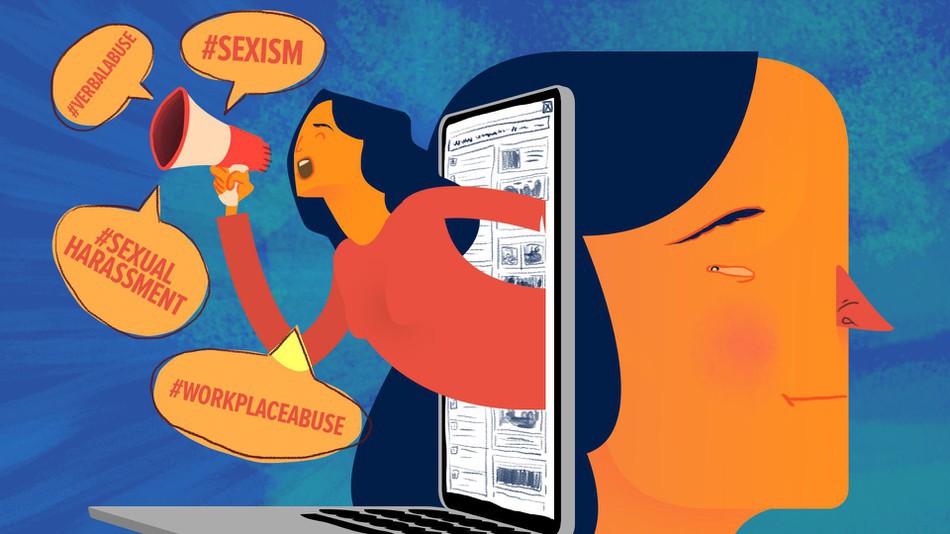‘Women Are Dying a Second Time at the Hands of Patriarchal Media’

‘Anyone who implicitly or explicitly justifies gender inequality and violence against women, does not intervene, and keeps silent, participates in this crime.’ With these words, Attorney Selin Nakıpoğlu draws attention to the fact that the patriarchal media, which prepares the news with a sexist language, is also a partner in crime in violence against women and femicide in Turkey. The editor of Bianet, Evrim Kepenek, on the other hand, emphasizes that the perpetrators are acquitted, and the women are made criminals in the news prepared with the worry of ‘clicks.’
The brutal murder of Azra Gülendam Haytaoğlu last week by a man was the latest example of reporting the representation of women in the media in a predominantly sexist language in Turkey. Especially in the news prepared by male journalists, there was a language that disregarded the rights of the victim women and even allowed the perpetrator to be justified.
‘It is mandatory for journalists to use gender-equal language when preparing news about femicides.’
Turkish Journalists Association (TGC) Women Journalists Commission also made a statement drawing attention to the increasing number of femicides and the problems in the spelling used in the news of femicide in the media. In the statement, it is stated that ‘journalists must use a gender-equal language while preparing news about femicides’, and journalists are invited ‘to be a follower of whether a deterrent penalty is applied while following the opinion about the news in question, and to do their duty to prevent violence against women, regardless of men or women.’
Some women writers reacted to these news reports that ‘wrote the murder from the murderer’s point of view, guided people wrong and the murderer’s false statements are sugarcoated’ and that Azra’s photographs are presented together with the murderer.
Some male journalists, such as Faruk Bildirici, also pointed out that the biggest mistake made by the media in the news of violence and murder against women is ‘turning it into bloody pornography’. According to Bildirici, reporting the murder of women in details and in a pornographic language renders the violence and bloody savagery invisible, potential attackers are shown the way. The traumatic effect it will have on healthy people and young women who read such news is also ignored.
We talked to lawyer Selin Nakıpoğlu and Bianet women and LGBTI news editor Evrim Kepenek, about Azra Gülendam Haytaoğlu murder, the reasons why violence against women and femicide are covered in the media in a way that spreads violence and violates the legal rights of the victims, and how readers should take a stand against it.
‘Everyone Who Justifies Violence Against Women and Stays Silent Participates in This Crime’
Evaluating the reporting of femicides in the media with its legal dimension, Selin Nakıpoğlu notes that she prefers to use the term ‘male violence against women’ primarily because she is a subject of systematic violence. Reminding that in the written and visual media, 60% of male violence against women and especially murders are ‘third-page news’, Nakıpoğlu draws attention to the fact that these are also reported as ‘judicial events’ without considering the gender dimension.
According to Nakıpoğlu, who said that ‘the murderer’s name is given with his initials and the killer’s statement “We had drunk alcohol” is persistently published, as in Azra’s example, is a way of reporting that we are quite accustomed to’ states that ‘even before the indictment is prepared, the reasons for remission and sometimes unjust provocation for the murderers are underlined. Essentially, this is judicial intervention.’
‘Male violence against women is systematic and is essentially an organized crime committed with the explicit or implicit approval of many institutions and groups.’
Nakıpoğlu summarizes the legal dimension of the issue with these words: ‘Male violence against women is systematic and is essentially an organized crime committed with the explicit or implicit approval of many institutions and groups! Not only the murderer, but also anyone who justifies, implicitly or explicitly, does not intervene, keeps silent about gender inequality and violence, participates in this crime.’
Nakıpoğlu gives the following answer to our question whether the coverage of the private life of the victim woman in the news of femicide violates the rights of the victim and how the rights of the deceased victim will be protected:
‘The news is usually murder-incident focused; it is based on court records and statements of the perpetrators. Whether the woman is a victim or not, she is subjected to secondary victimization throughout the criminal proceedings. This is a violation of the right to respect for private life if the woman is alive, and if she is not alive, it is a crime to insult the moral personality of the deceased. And the courts listen to the male defendants recklessly insulting the woman during the trial and the violation of respect for the private life of the woman throughout the trial, and they keep silent about these.’
In this regard, the European Court of Human Rights made an important decision regarding the protection of an applicant who was subjected to male sexual violence from secondary victimization last May.
‘Language Is One of the Main Elements Carrying a Gender Ideology’
Nakıpoğlu describes the fact that even experienced male journalists such as İsmail Saymaz violate the rights of women who are victims of such a fire in the media, as an example of ‘reproducing the sexist mentality as a public policy in all areas of life’.
Noting that journalists, in particular, do not use the term ‘male violence’ in the news, because they reject the fact that women are ‘killed because they are women’, Nakıpoğlu draws attention to the importance of language: ‘Because language is one of the basic elements that carries the sexist ideology at the source of male violence against women, anyone who does not pay attention to the language and reproduces this language with the words, idioms and expressions they use is a partner in this crime.’
Evaluating the role of the media in violence against women and femicide as a lawyer, Selin Nakıpoğlu advises reporters to inform the public about femicides, to follow the legal process, to reveal the gender inequality dimension of the process when necessary, and to continue the follow-up until the process is concluded.
‘Rather than turning male violence into melodrama, journalists should use their pages to raise awareness and question the sexist legal system because women die a second time at the hands of a patriarchal media.’
Underlining that not only the members of the media but the entire society are responsible for commodifying women who have been subjected to male violence with photographs and ending the disclosure of all details about them, Nakıpoğlu said, ‘Every member of the press who does not give up the pornography of violence in the reporting of male violence against women commits a crime’.
Finally, Nakıpoğlu stated that she found the news about male violence by media organs such as Birgün and Bianet successful and described it as a very important service for Bianet to make a breakdown of male violence in Turkey, where data on male violence is not collected.
‘Femicide News Make People Feel “This Woman Deserves It!”’
After Selin Nakıpoğlu’s evaluation of male violence against women and femicide from a legal perspective, Bianet women and LGBTI news editor Evrim Kepenek, who dealt with the issue from a journalistic perspective, says that the media is worried about ‘clicks’ and that they make people feel ‘This woman deserves it’ with the news.
She states that the way Azra Gülendam murder was reported in the media brought the reader to the point of ‘Oh, what kind of family raised these girls’, and points out that the perpetrator was acquitted in this news, while the woman was portrayed as the guilty party.
To our question whether the coverage of all the details and the private life of the victim woman in the news of femicide attracts more attention of the public, Kepenek gives the following answer: ‘It is necessary to write this news without thinking if it is read more. So, when writing some news, ask yourself two questions: “Who is this news for?” and “Am I victimizing the woman and the child again in this news?” That’s when you write the news without worrying about being “read” or “not read”.’
‘Perpetrator Man is Acquitted, Victim Woman Becomes Guilty’
She emphasizes that the reason why male journalists, in particular, prefer to shape their news with the photographs of the victims, their private lives, and the details of the murder, rather than the accused, is not due to the lack of information because it is very easy to access information:
‘“Who is this news for?” and “Am I victimizing the woman or the child again in this news?” If you follow these questions, you will somehow reach the right information. There are numerous resources on this subject. I think male journalists who write such news can better answer the “why” question. You know since they are experts on everything!’
Kepenek suggests Turkish Journalists Association (TGS) “Etik Gazetecilik İçin Cinsiyet Eşitliği Rehberi” (Gender Equality Guide for Ethical Journalism), Turkish Journalists Association’s “Toplumsal Cinsiyet Eşitlikçi Haber Kılavuzu” (Gender Equal News Guide) and Bianet’s gender library and “Toplumsal Cinsiyet Odaklı Habercilik El Kitabı” (Gender-Focused Journalism Handbook) for journalists to report on femicides in accordance with journalistic ethics and gender equality norms,
Kepenek, who we asked the readers for their suggestions for the news language to be prepared on the axis of gender equality, says that the institutions that make news that harm women and children should report this situation and these warnings should be shared on social media.
Evrim Kepenek reminded that Bianet’s 141 news stories, including the ‘Male violence tally’, have been blocked, and states that even this example alone reflects the conditions we are in and the way we look at women well, and despite everything, she gives the message to ‘continue to write and read for women with women’.

Bizi Takip Edin